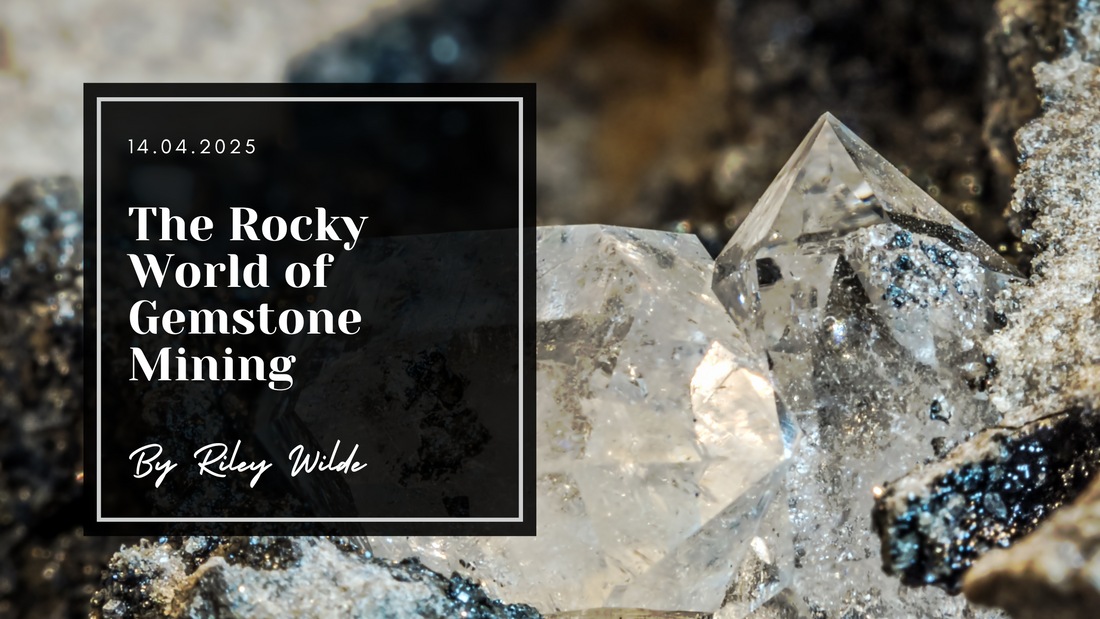
The Rocky World of Gemstone Mining
Share
Hi you lot!
As I’ve recently announced, I’ll be creating a range of engagement and wedding jewellery in the coming months, and while designing and deciding what gemstones to use, I ended up down a giant diamond mine rabbit hole and I wanted to share what I found with you. It’s a long one though so put make a brew and grab a biscuit or two before you settle in for the read.
Let’s start with the most obvious stone and the basics...diamonds.
WHAT ARE DIAMONDS?
A diamond is a natural gemstone made from pure carbon that has been compressed in the earth over millions of years. They are extremely hard, and can be incredibly beautiful, clear and shiny. Due to the durability of diamonds, they are used in all sorts of different industries but since I’m a jeweller we’re going to talk about diamond jewellery.

WHY DO WE LOVE DIAMONDS?
This is a tricky one, as I’m not looking to get sued or make any enemies! Here’s a quick story for you to give you an idea.
In the 1940’s, a diamond mining company called De Beers was in decline due to The Great Depression and employed advertising agency, N.W. Ayer & Son, who had a revolutionary idea: The Diamond Engagement Ring. Before the infamous “Diamonds are Forever” marketing campaign, only 10% of engagement rings contained a diamond, and since then that statistic has risen to 80%. This is because they went HARD on their advertising, even as far as introducing the trope in Hollywood movies – I’m sure you’re thinking of Marilyn Monroe’s rendition of “Diamonds are a Girl’s Best Friend” right now!

ARE DIAMONDS RARE?
Contrary to popular belief, diamonds aren’t particularly rare but pure, clear ones are less common and that’s part of why diamonds are regarded as the ultimate gemstone (although, personally, I prefer the look of salt and pepper diamonds with all their beautiful inclusions!).
The mainstream diamond supply is very meticulously controlled, with only enough rough diamonds being released to satisfy to current demand, which drives prices up. There are actually billions of diamonds locked down in high security warehouses to artificially inflate the price!
THE PROBLEM WITH NATURAL DIAMONDS
Working Conditions
Since diamonds grow in the earth, people have to mine them. The problem is that most diamonds occur in parts of the world that have a wealth of valuable, naturally occurring resources, which tends to go alongside an unstable political democracy due to a fight for those resources.
Forced labour and child labour go hand-in-hand with the mining of natural diamonds, particularly in the Democratic Republic of Congo, where people as young as 6 years old are forced to work for as little as $2 a day using their own tools and bare hands.

There is a ludicrous amount of violence inflicted on the people who live in these areas including murder, sexual violence, forced displacement and a lack of humanitarian aid, schools, and hospitals.
Blood Diamonds
Blood diamonds are diamonds that are mined in these warzones, like mentioned above, and the profit from selling the diamonds goes towards weapons and further insurgency, repeating the cycle.
AREN’T THERE CONFLICT FREE DIAMONDS?
The Kimberly Process Certification Scheme (KPCS) was set up in 2003 to remove blood diamonds (conflict diamonds) from the market by certifying that a batch of diamonds hasn’t financially benefitted rebel groups.
One of the problems though, is that working conditions, wages and child labour aren’t taken into consideration and neither is the forced displacement of communities in order to mine where their homes once were.
Another problem is that due to the KPCS being applied to a batch of rough diamonds and then exported elsewhere to be cut, polished and sold, the KPCS doesn’t apply to the diamond itself so it’s impossible to trace them from mine-to-store. KPCS certificates are also regularly faked, which is a whole different problem of its own.
This doesn’t mean that conflict free diamonds don’t exist – it’s just that in an industry built on famously poor working conditions and flooded with blood diamonds, it’s impossible to know which diamonds are conflict free and which aren’t.
MINE-TO-MARKET
There are some amazing indie diamond suppliers out there who ensure that they source their diamonds from conflict-free zones where the workforce are valued (no child labour, fair wages, good PPE, working hours etc) and then either cut the diamonds in their own facilities or through a trusted facility that also have high worker standards.
This ensures that due to the very direct supply-chain the diamonds are fully traceable and guaranteed to have not only not violated any human rights, but actually support the local communities by paying a proper wage.
THE ECOLOGICAL IMPACT OF DIAMONDS
Mining companies who use “pit mines” use heavy duty explosives to blow enormous pits in the ground and break up the ore. Then heavy duty machinery can go in, excavate and extract the diamonds. This has a huge environmental impact on the land in terms of loss of habitat and disrupting delicate, natural ecological systems. It also pollutes the earth by burning millions of gallons of fuel to power machinery, not the mention the pollutants from the initial explosives.

Some diamonds are found in riverbeds which are called “alluvial diamonds”, where a more old-school technique of panning for diamonds is involved. This is hard to manage securely and holds all the same risks for the miners we mentioned earlier, such as poor working conditions and threat of violence. Additionally the riverbeds become damaged, eroded, polluted and the aquatic life is destroyed.

Marine mining is another machinery-heavy operation where enormous vessels dredge up sediment from the ocean floors. These fuel hungry machines are huge polluters, whilst destroying natural habitats and disturbing migratory marine life like sharks, whales and dolphins, etc.
ARE SALT AND PEPPER DIAMONDS MORE ETHICAL?
There is an argument that salt and pepper diamonds are more ethical than clear ones because of their sheer abundance, but they still require all of the same conditions to be mined so in my opinion their global impact is the same.

WHAT ABOUT LAB-GROWN DIAMONDS?
Lab grown diamonds are chemically and physically composed EXACTLY the same as a natural diamond with all of the same beauty and properties, but instead of being mined from the ground they are created in a lab from carbon under extreme high pressures and temperatures!
Heating carbon to the same temperature as the surface of the sun for a few days takes a huge amount of energy to do, so we can definitely agree that while they’re more environmentally friendly than mined diamonds, they still take a huge amount of energy to produce.
Creating a single carat of lab-grown diamond takes somewhere between 250 - 750 kilowatt hours (kWh) – to put that into perspective, the average UK home only uses between 8 - 10 kWh per day.
A handful of independent diamond labs are stepping up to the task of using only renewable energy to create their diamonds, though, such as companies like Brilliant Earth who use wind and solar energy, so this is looking like a really great alternative if you shop for renewable lab diamonds. Especially because even experts can’t tell the difference between a lab-grown or earth-mined diamond and they cost a fraction of the price!
SO WHAT DO WE DO TO SOURCE THEM RESPONSIBLY? ARE THERE ANY OTHER ALTERNATIVES?
Yes!
Buying from mine-to-market traceable suppliers like I mentioned above. That’s a great way to show the industry how to get it right!
Buying vintage diamonds, or recycling diamonds from your old jewellery is a fantastic way to use resources that are already in circulation without contributing to the harm behind the mined diamond industry! Once your diamond leaves the jewellery store, the value plummets, much like buying a car – that really sucks if you’re buying a new diamond, but it can really work to your advantage if you’re shopping for an old one!
Moissanite is a synthetic stone that’s often used in place of a diamond that’s grown in a similar way but using silica instead of carbon. It has a similar hardness and appearance to diamond however it refracts light into more colours than diamonds so it can appear more sparkly, however some people think this can make it appear a bit artificial. Moissanites do exist naturally but only from meteorites, which is super rare, so the majority are lab-grown meaning they’re only “artificial” in the same way that a lab-grown diamonds are – it’s simply a matter of preference. They often price quite a bit lower than lab diamonds too.

Other gemstones are always a fantastic option! Don’t forget that before De Beers ran their huge campaign, most people didn’t even have diamonds in their engagement rings, let alone the rest of their jewellery and some other easily-available gemstones are simply stunning – not to mention a fraction of the price!

DO OTHER GEMSTONES HAVE THIS HARMFUL BACKGROUND?
Yes, unfortunately they do. The history of sapphire mining in Myanmar and Cambodia is very bloody and the ecological impact of mining for any gemstone can be harmful.
The thing that sets other gemstone mining apart from the diamond mining industry is its scale – 70% of the coloured gemstone mining industry are small scale which means they’re far less damaging to the environment. They’re also more likely to benefit the local communities in which they’re found due to there being less of a barrier for the communities to begin mining and selling them.
Most gemstones are very hard to trace back to their original mines, even if you know what country they originate from, due to how many times they change hands between being mined and being sold. They’ll often be mined in one country and then sold to a completely different country to be cut, polished and then sold on again.
These factors don’t mean that it’s not important to ensure that coloured gemstones aren’t sourced responsibly though – it’s still important to check that all along the supply chain that working conditions and environmental impact meet a high standard. Many stone selling operations these days have relationships with their stone cutters, who have relationships with their miners, so assurances can be made. Just like with diamonds there are fully traceable mine-to-market operations for coloured gemstones but this means that the gemstones cost significantly more when bought from these organisations.
All that to say – I’ve learned a LOT during this deep-dive. I’ve begun the mammoth task of asking all of my gemstone suppliers if they know how their stones were mined and under what conditions; and if I’m not satisfied with their answers I’ll be finding a different supplier who’s answers I am happy with! This means I’ve built up my very own mini-directory of trust-worthy suppliers that I vow to stick to going forwards.
I hope you’ve enjoyed coming along with me on this journey and have learned the importance of responsibly and kindly sourcing your gemstones (or literally anything to be honest!) as well as I have!
~ Riley x
Sources:
https://ethica.diamonds/blogs/news/lab-grown-diamonds-impact-on-the-environment-sustainability
https://www.gemsociety.org/article/are-diamonds-really-rare/
https://frankdarling.com/blog/7-reasons-not-to-buy-a-natural-diamond/
https://frankdarling.com/blog/do-sustainable-diamonds-exist/
https://www.theguardian.com/sustainable-business/diamonds-blood-kimberley-process-mines-ethical
https://www.kimberleyprocess.com/
https://www.brilliantearth.com/en-gb/lab-diamond/renewable-energy/
https://www.theguardian.com/lifeandstyle/2020/mar/10/diamonds-lab-grown-climate-change
https://gembreakfast.com/blogs/news/the-most-comprehensive-guide-to-buying-ethical-gemstones

1 comment
Thanks for writing about this very difficult and complex topic.
Which diamond suppliers would you recommend? I am occasionally asked for advice and I struggle to give an answer to where people should buy their diamonds.